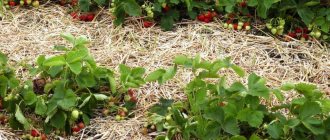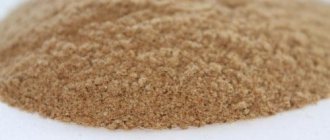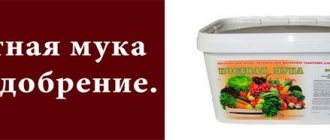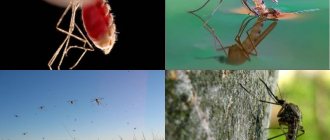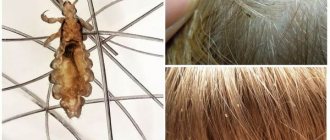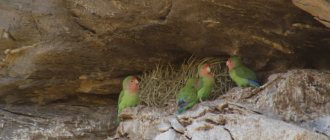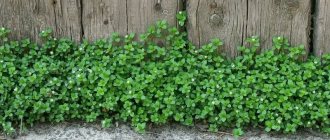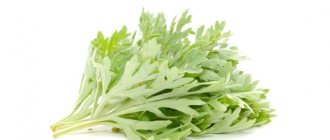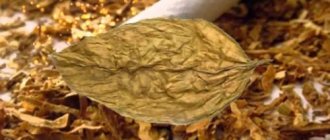Rabbits are raised for their beautiful fur and dietary meat on large farms and in households.
Therefore, the problem of disposing of their excrement is acute for both farmers and homestead owners.
Improper use of rabbit manure causes a lot of harm, so the owners of these animals must know the basic rules and regulations for handling their excrement and be able to use it so that it is beneficial, particularly for the garden.
After reading this article, you will learn:
- is it possible to use rabbit manure as a fertilizer, and how can it be useful for the garden;
- how to prepare fertilizer from it and when is the best time to apply it to the soil;
- how to dilute for irrigation;
- what can be fertilized with it;
- For what other purposes can it be used in a summer cottage?
Is it possible to use rabbit manure in the garden?
Fresh rabbit manure is a very aggressive substance that kills any vegetation, including weeds. If such excrement is dumped on the ground, then even after it rots and is cleaned up, nothing will grow there .
The fact is that the active process of rotting occurs only inside the heap of manure, while the liquid from it permeates the ground, and aggressive substances remain in it for many years.
But when the decay process is completed, this material turns into a very good complex fertilizer that improves the structure of the soil and restores the nutrients given to plants. Therefore, you can use rabbit manure in the garden , but strictly following the rules outlined below.
Useful tips
- Watering is done on cloudy days, so the fertilizer is better absorbed and evaporates less (if it is liquid);
- Watering is carried out at the root (in the tree trunk circles), without spraying the stem and leaves;
- If the soil is dry, it should be shed with water before adding it;
- Rabbit manure contains a lot of alkaline elements, so it reduces the acidity of the soil. It cannot be added to soil that is neutral or alkaline in composition. This will limit the plant's absorption of phosphorus.
- The prepared, infused solution should be stored in a special container covered with a mesh.
- You should not fertilize plantings with untreated manure: its breakdown products - ammonia and methane - will burn the young shoots.
Chemical composition and properties
Rabbit excrement contains noticeably more organic matter, that is, digested food (on average 30%), than waste from any other animal or bird. At the same time, it is less moist, so the proportion of water in fresh feces does not exceed 50–60% .
The share of other elements, such as:
- nitrogen;
- phosphorus;
- potassium;
- calcium;
- magnesium;
- manganese;
- iron,
is also noticeably higher and falls within 0.1–0.5%. But after rotting and reducing the humidity to a level of 30–40%, the content of organic matter and other elements approaches the average for all types of humus from any excrement.
Methods of use from spring to autumn without harm to plants
Each method, with rare exceptions, is applicable only for a certain season , and its use on a summer cottage in another season will lead to the pointless destruction of manure or humus, and in especially unfortunate cases may result in a decrease in yield or death of the plant.
in spring
In early spring, rabbit manure can be used both to heat the soil of greenhouses, and can be used for “warm” beds, poured into a pre-dug trench, where, after the rotting process has started, fertile soil will need to be filled.
Also, in early spring, partially rotted excrement can be used to fertilize fields that are left fallow.
Suitable for this purpose is manure that has lain on pus under a film for at least a year or has been kept in an insulated box/pit after treatment with bacterial preparations for at least a month (if the pit is not insulated, then at least six months).
During flowering, plants are fertilized with “chatter” of manure. To do this, feces are mixed with water in various proportions and left for 10–30 days so that the bacteria have time to process most of the organic matter.
If you use the slurry immediately after mixing, then even unconcentrated it will harm the plants, because intestinal enzymes, which pose the greatest threat, will not have time to turn into humic acids, and the plant will receive a nitrogen burn.
In summer
In the summer, the fruits of most plants ripen, so they cannot be fertilized not only with fresh or partially rotted excrement, but also with loose excrement, because this will lead to an increase in nitrogen compounds (nitrates) in the fruits.
However, this does not apply to plants whose fruits are not food for people or any animals or birds.
Therefore, any preparations based on rabbit manure that are suitable for plants in terms of the amount of intestinal enzymes can be used without restrictions to fertilize flowers and non-fruit plants. Most often, bumps are used, and partially or completely rotted manure is laid out around the trunks.
in autumn
After the fruits ripen, it is undesirable to fertilize the plants, because they are either preparing to go into winter mode or die off.
Therefore, they fertilize the soil either after the leaves have fallen, when the plant has entered the winter mode of existence, and the appearance of new nutrients will not cause pointless growth of green mass, or after dead plants have been removed and the soil has been prepared for winter .
In the fall, the method of fertilization depends on the plans for the next year - if the area is left fallow, then half-rotted excrement is poured onto it, after which the soil is plowed or dug up.
Over the winter, the soil will be saturated with organic matter from excrement and will turn into a breeding ground for humus-forming bacteria and various underground creatures, whose vital activity loosens the soil and turns any organic matter into humus.
Due to the high concentration of intestinal enzymes and other toxic substances, even weeds will not grow in such soil; on sunny days it will warm up well, which means that the activity of humus-forming bacteria will sharply increase.
Types of use
Rabbit manure used in agriculture is divided into the following types:
- Fresh.
- Dry.
- Composted.
- Humus.
It is advisable to use fresh after harvesting in late autumn. It is mixed with mulch and applied to the soil. During the winter, it decomposes, and harmful ammonia and methane disintegrate. Spring waters will saturate the soil for planting with it.
Rabbit manure is the only organic fertilizer that can be used in dry form. To obtain it, the component is dried in the fresh air by sunlight, ground and mixed with soil. When using it, spread it evenly in a thin layer. Dry manure can be used to create liquid fertilizers to fertilize indoor plants.
A compost pile is made by mixing food scraps and grass clippings with various types of organic fertilizers, particularly rabbit manure. It is then darkened with an opaque coating. After 45 days the pile should be compacted.
Humus, or otherwise humus, is completely decomposed homogeneous compost processed by red Californian worms. It is applied to the soil after harvesting, a week before winter crops are planned to be planted. After spreading the humus, the entire soil is dug up.
In what form is it used on a summer cottage?
Rabbit excrement can be in one of the following states of aggregation :
- fresh;
- dry;
- partially rotten;
- completely rotten;
- aqueous solution (feeding).
Fresh
Before rotting, that is, fresh or partially rotted excrement can only be used if it comes from healthy rabbits.
After all, the feces of sick animals pose a serious threat because they contain pathogens that, through birds feeding on dung beetles or worms, can infect other animals or people.
Therefore, the waste of sick rabbits is taken out to a pustule and, after treatment with bacterial preparations, covered with a film or tarpaulin until complete rotting.
Dry
Dry rabbit manure can be in the form of cakes, which the owners of these animals dry themselves, or granulated.
During drying, substances aggressive to plants lose moisture , without which they cannot interact with any parts of the plants.
Also, during drying, most pathogenic microorganisms, including worm eggs, die, so dried excrement is relatively safe. At the same time, they contain many microelements and all the original organic matter, therefore they are a good fertilizer.
Completely rotten
After complete rotting, manure turns into humus (humus), which can be used without restrictions at any time of the year.
Indeed, even during fruit ripening, fertilizing plants with humus does not lead to filling the fruit with nitrates .
In its structure and content of substances necessary for plant development, humus is very close to natural forest soil, because the same processes occur in it as in excrement during decay.
Partially rotted
Due to the fact that under natural conditions the process of rotting lasts several years, but not everyone has the opportunity to wait that long or speed up rotting with the help of an insulated box/pit and bacterial preparations, partially rotted manure is popular.
It contains much fewer toxic substances, in addition, it contains humic acids , although in smaller quantities than after complete rotting.
If the excrement was kept in an insulated container or pit, then even after partial rotting, all pathogenic bacteria and worm eggs die in it.
After all, insulation reduces the loss of heat produced by bacteria, thanks to which they have time to destroy the proteins of bacteria and seeds until they are completely unviable. However, partially rotted excrement that has been stored on a pus-filled bed still contains a lot of living bacteria and eggs, so it must be handled with care.
Water solution
Fresh and partially rotted excrement of healthy animals can be used to make fertilizers.
However, after stirring, the solution must be kept for at least 10 days so that the bacteria have time to process most of the substances toxic to plants.
It is acceptable to use freshly prepared fertilizer, but for spraying foliage it is heavily diluted to reduce the level of toxic substances, and it can only be watered in areas left fallow, and even then only in mid-autumn or early spring.
Common Mistakes
If used incorrectly, it can cause damage rather than benefit to the crop. This applies to the timing when fertilizer is added to the post office. It should occur before winter and early spring. During the fruiting period, fertilizing should not be done.
The use of freshly obtained manure is unacceptable, since its decomposition releases toxic gases. Such fertilizer may lose its positive properties if stored improperly. Incorrect proportions when preparing solutions are unacceptable.
What crops can be fertilized?
Humus from rabbit excrement is suitable for any plants whose natural habitat is steppes or forests , because such plants feed on humic acids.
If the plants live in the desert, then they cannot be fertilized not only with humus from rabbit waste, but also with any products based on excrement, since even the poorest forest soil is too nutritious for them, and an excess of nutrients will lead to disease or death of the plant.
Partially rotted excrement is also suitable for any forest or steppe plants, including all vegetable and garden crops, however, due to the strong acidifying effect, the acidity of the soil and plant preferences are of great importance.
For example, cucumbers like moderately acidic soil (pH 4.5–5), and tomatoes love neutral soil (pH 6–8) . If the soil has a higher pH (alkaline), then the acidification produced by rotting manure will benefit the plant.
But if the pH fully meets the requirements of the plant, then adding fresh or partially rotted material without reducing the acidity will greatly harm it.
The acidity of fresh excrement is very high (pH 1–2), in addition, humus-forming microorganisms produce additional acids that further change this parameter.
Partially rotted material has a pH of 3–4.5, and ready-made humus has a pH of 7–8.
By measuring the acidity of the soil using folk signs or a pH meter and knowing the plant requirements for this parameter, you can determine whether this plant needs to be fertilized with manure or a preparation based on it without adjusting the pH or not.
Fertilization of different crops
It is worth understanding that complementary foods are introduced to different crops at a certain phase of growth and development. Let's look at popular options:
- It is recommended to use onion fertilizer before the bulbs form.
- For nightshades, such as potatoes, tomatoes, eggplants, and capsicums, fertilizing is done before mass flowering.
- Tomatoes, for example, are more sensitive to nitrogenous compounds, so use liquid fertilizer with caution, after trying it on a couple of bushes first. Warm beds are prepared a week before planting seedlings or seeds.
If you dig up the soil with the droppings of an eared animal in the fall, then by spring the soil will be saturated with useful substances. Rabbit droppings can be used not only in garden beds, but also for feeding trees and shrubs, as well as in greenhouses.
How to dilute for irrigation?
Regardless of the type of initial product (fresh, semi-rotten or dry), one dilution algorithm is used. First, the raw materials are mixed with a small amount of water, that is, for 1 kg of manure of any condition, 3–5 liters of water are required.
Both components are mixed, then stirred several times to dissolve even small solid fragments. When the mixture turns into a homogeneous substance, place it in a well-lit place and cover loosely with a lid.
The rate of decay, and therefore the readiness of the mash, depends on:
- outside temperature;
- solar activity;
- treatment with bacterial preparations.
The higher the air temperature and the hotter the sun shines, the faster bacteria will process organic matter, so the decay time in summer is 2–4 times less than in early spring or late autumn.
Treatment of the material with bacterial preparations also accelerates decay several times.
Moreover, the effectiveness of bacteria directly depends on the temperature of the mixture - the higher it is, the faster the microorganisms will act.
The readiness of the mixture is determined based on the purposes for which it is made and the requirements for roughness. For irrigating fields under fallow, a top dressing is suitable, in which the smell of rabbit manure has become noticeably less, but the swamp smell has not yet appeared.
Before spraying foliage or spring watering fallow fields, you must wait until a strong marshy smell appears. To water the plants throughout the year, you must wait until the swampy smell disappears.
Efficient composting
Candidate of Agricultural Sciences Alexander Gorny recommends adding rabbit droppings to mixed compost heaps. It is best to alternate it with:
- food and other organic waste,
- hay, straw, weed clippings without seeds,
- sprinkle the surface well with ash,
- To speed up decomposition, spill the compost with Baikal.
After the heap is replenished, it is covered with a small layer of earth. The width and height of the collar should not exceed 1.5 m.
Don't let the pile dry out!
During periods of drought, the compost heap should be watered generously. In early spring and before autumn frosts, it is useful to shovel without compacting.
To comply with sanitary standards, manure should be composted in a remote area from housing and wells. It is recommended to cover the surface of the compost heap with black film. The cover will not only eliminate the unpleasant odor coming from the heap, but will also speed up the maturation of the compost. The temperature under the film will increase, which contributes to the death of weed seeds.
For reference. The weight of 1 cubic meter of rabbit manure is about 500 kg.
Vermicompost
You can add manure worms to your compost heap to help improve the quality of the compost. This is done after the first phase of maturation has passed, if beetles and other insects have appeared, then worms can be added. For best propagation, dig corrugated cardboard into the pile.
Important! The pile with worms must be frequently moistened and protected from overheating. In winter, to prevent living creatures from dying, the manure is covered with a layer of straw or hay.
Manure processed by worms acquires a uniform crumbly structure and contains no weed seeds. Vermicompost or vermicompost can be used as follows:
- add to the holes when planting seedlings and planting potatoes (about a handful for each hole);
- Dissolve 100 g of vermicompost in 1 liter of water and spray vegetable seedlings and indoor plants.
Secondary dilution with water
The infused solution is mixed with water, and the concentration depends on the purpose . We have prepared a table which includes:
- purpose of feeding;
- the state of the tincture (fresh, partially or completely rotten);
- proportion of mixture and water.
| Purpose | Feeding status | Proportion (liters of water per 1 liter of tincture) |
| Spring watering of fallow fields | Any | 1–10 |
| Autumn watering of a fallow field | Partially or completely rotted | 1–20 |
| Watering before planting seeds or seedlings | Completely rotten | 50–100 |
| Watering planted seedlings | Completely rotten | 30–100 |
| Watering when flower or leaf buds appear | Completely or partially rotted | 30–100 |
| Watering during flowering | Completely or partially rotted | 30–100 |
| Watering during fruit ripening | Completely rotten | 50–200 |
| Watering when there is a lack of minerals and nutrients (yellowing leaves, etc.) | Partially or completely rotted | 10–200 |
| Spraying foliage | Any | 150–200 |
For breeding, only unboiled fresh water is suitable , preferably rain or river. Tap water is saturated with chlorine, which suppresses humus-forming bacteria. If you only have tap water, then you need to let it sit for two days so that the chlorine comes out.
Fertilizer in greenhouses
You can grow plants in such conditions for a long time. Rabbit droppings can be sprinkled under all types of plants grown in a greenhouse: cucumbers, tomatoes, eggplants, peppers. This will give the same positive effect as fertilizing plants grown outdoors. Before planting seedlings, the ground must be prepared. To do this, it is mixed with humus. The fertilizer solution is poured into the grooves made, the soil is mixed and covered with film. After two weeks, the soil in the greenhouse is dug up and the seedlings are planted.
How to deposit?
The method of application depends on the condition of the excrement.
Fresh, partially rotted or in the form of humus is delivered to the field using a hand wheelbarrow, as well as a trailer to a walk-behind tractor or walk-behind tractor. On rabbit farms, it is advisable to use a spreader trailer for this; it speeds up the distribution of material over the surface of the earth and eliminates heavy manual labor.
Owners of a small population of rabbits will have to do all the work manually, delivering excrement/humus to the field using a trailer to a mini tractor/motoblock or a hand wheelbarrow.
As the wheelbarrow moves, the contents are laid out on the surface of the ground in small piles using a fork or shovel. When all the manure is distributed over the field, it is advisable to plow or dig up the area; this will mix the humus with the soil, due to which the nutrients will be distributed throughout the entire depth of the fertile layer.
If it is necessary to fertilize a separate plant, then the material is laid out around the trunk, with only humus placed close to the trunk , partially rotted manure is laid out at a distance of 10–30 cm from the trunk, and fresh manure is laid out at a distance of 50–100 cm from the trunk.
When manure/humus is laid out, the soil under and around it must be dug up by hand in order to evenly distribute the fertilizer throughout the fertile layer and facilitate access for plant roots to it.
Is rabbit droppings used as fertilizer?
Pet excrement has been used to fertilize garden beds since time immemorial. Cattle and horse manure are best suited for this purpose. Other types of litter are used less frequently, although they can also be used in this capacity after some preparation. Rabbit manure also falls into this category.
Rabbits are not only valuable fur, but also... 100-150 kg of manure per year
On private farmsteads, where the number of rabbits is low, a small amount of litter is produced, and its disposal, as a rule, is not a problem. However, in specialized farms, where the number of these animals is measured in hundreds and thousands, quite a lot of rabbit manure can accumulate.
How to water and spray?
For irrigation, use the required concentration of slurry. If it is necessary to water the entire field, then a tank trailer is used to mix the slush, into which water and tincture are poured.
If you first pour out the tincture, then add the required amount of water, the water filling the tank will additionally mix the mixture already in the tank.
The tank is then transported to the field using a tractor and poured onto the ground in various ways. The most convenient is a mounted injector , powered by the tractor's power take-off shaft or its own motor.
If there is no such device, then you can pour the mixture by gravity through a hose, gradually moving the tank across the field.
Owners of small farmsteads can mix fertilizer in metal or plastic containers installed near the garden, then pour it through a hose by gravity or using a fecal drainage pump.
You can also deliver fertilizer to the plants using buckets and pour the liquid under the root and around the trunk. But in this way it is difficult to fertilize even relatively small (10–20 m2) areas, unless the barrel is located directly on the area or close to it.
To spray the foliage, strain the tincture using several layers of gauze , then dilute with water to the desired concentration.
The finished mixture is poured into garden sprayers with a telescopic extension, then protective equipment is put on (goggles and a respirator, this is especially important when working with fertilizer containing fresh excrement) and the foliage is sprayed both from above and from below.
Reviews
Reliable opinions on the use of rabbit manure to fertilize various plants can only be found on thematic forums, where users share personal experiences and answer each other’s questions.
Therefore, we have prepared a list of forums whose users leave their reviews and share tips on how to use rabbit manure as garden fertilizer:
- Farmer RU;
- Our Dacha;
- Yaroslavl forums;
- Main portal for rabbit breeders;
- Forum of rabbit breeders of Ukraine;
- Fishing Club Volga Fishing;
- Farmer BY;
- Merry courtyard;
- I am a Farmer.
Advantages
To the question whether it is possible to use rabbit droppings as fertilizer, you can answer this way: not only is it possible, but it is also necessary. Areas dominated by clay are poorly supplied with air. Plants do not receive enough oxygen and develop worse. Rabbit manure as a fertilizer, according to gardeners, after three years of regular application makes the soil loose and moisture-absorbing, which helps to increase the yield of vegetable and berry crops.
Rabbit manure is used for gardening in dry and liquid form. It can be composted. A one-time application of the required dose can replace a three-kilogram package of complex mineral fertilizer.
This type of fertilizer is preferable in greenhouses, as it has greater heat transfer than mullein or chicken droppings. Only horse droppings can compare with it, but it is harder to get. Rabbits are bred more frequently, so the use of rabbit droppings as fertilizer is more common. By laying organic matter to a depth of about 30 cm, you can warm up the roots of the seedlings naturally, without using other heating methods.
Vermicomposting rabbit manure with worms
Vermicomposting is the transformation of any organic matter into humus using worms. Under natural conditions, worms feed on organic matter that bacteria and other microorganisms cannot process, so their main food is dead plant roots.
However, they willingly eat any type of fresh manure, which, after passing through the digestive tract of the worms, turns into humus. Worms living in the ground sense a new food source from a fairly long distance, so after a few days they appear in the pile and begin to reproduce.
Moreover, this process occurs without human participation, because it is part of the natural mechanism for the utilization of organic matter and the circulation of substances in nature.
The only advantage of Californian worms is that they multiply quickly , but they thrive only in conditions similar to California, that is, in a Mediterranean climate with minimal temperature changes and warm winters.
In addition, they are very demanding on the nutrient medium, so you can’t just put them in a pile, this will lead to their death. In order for California worms to effectively process excrement, several conditions must be met:
- the temperature is not lower than +12, otherwise the worms first fall asleep and then die;
- stable temperature (maximum daily or three-day difference of 10–15 degrees), otherwise they slow down reproduction and sometimes lead to illness or death;
- laying nutritious material in layers, otherwise it is difficult for them to get to food;
- mandatory addition of chopped plant fibers;
- absence of dung worms, because their secretions are destructive for Californian ones.
That is, Californian worms do not provide any real benefits when rotting on pus , because they were bred for use in houses or apartments and for the disposal of kitchen waste.
And on the pus, after a few weeks, dung worms are included in the complex process of obtaining humus from fresh rabbit manure.
For use as fishing bait, ordinary dung or rain worms, as well as maggots, which are also actively involved in the process of obtaining humus from manure, are also suitable no worse than Californian worms.
Other uses
In addition to fertilizer, rabbit manure can be used to make both a substrate for germinating seeds, growing mushrooms and seedlings, and solid fuel .
To prepare the mushroom substrate, rabbit manure is mixed with sawdust or chopped vegetation and lime or ash. Mushrooms grow well on both fresh and rotted manure, and after the substrate is depleted, it can be used as a complex fertilizer for the garden.
To prepare a substrate for germinating seeds or growing seedlings, humus from rabbit manure is mixed with sand in a 1:1 ratio, that is, 1 kg of humus and 1 kg of sand.
Such a substrate will be especially effective in peat cups, because then the seedlings can be planted in the ground without being removed from the ground, and therefore without injuring the weak, delicate roots.
Rabbit manure contains a lot of organic matter, so it is well suited for the production of solid fuel. You will find a detailed description of the manufacturing process of such fuel here. There are other possible uses for rabbit manure, which can be found here.
Manure storage
Rabbit manure is rich in microelements, so in order not to destroy them, you need to know the rules for storing fertilizer:
- Rabbit manure does not tolerate too high temperatures. Many gardeners mistakenly believe that steaming or boiling water will kill harmful bacteria, when in fact this process will destroy and remove beneficial substances.
- To prevent drying out, store manure in a dark, moist, cool (not cold) place to prevent excess moisture evaporation.
- The quality of manure depends on the health of the rabbits and the quality of their food:
- food must be complete and balanced, containing all the microelements the animal needs. Only in this way will the quality of the litter be high and the harvest greater;
- manure also needs to be collected correctly. To prevent rabbits from getting sick, droppings should not be stored and accumulated inside the cage, but should go into special slots at the bottom or into a tray separated from the main part of the cage by a lattice.
